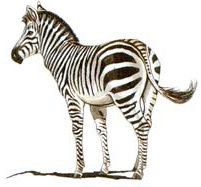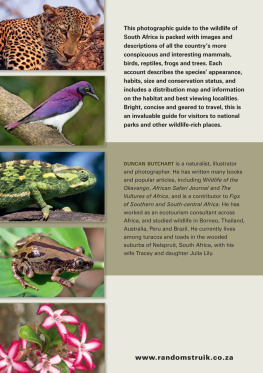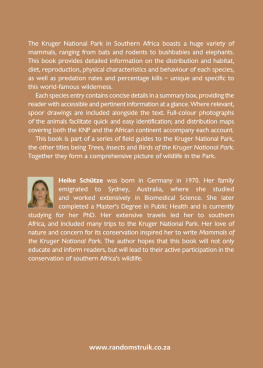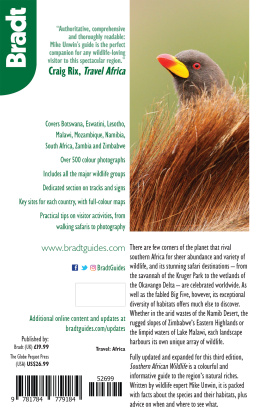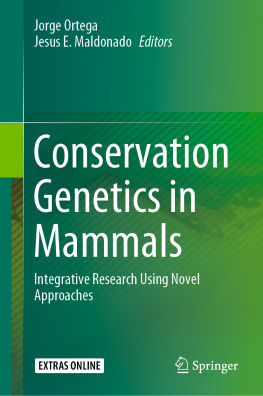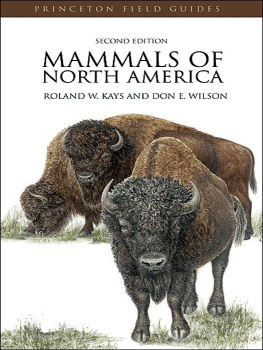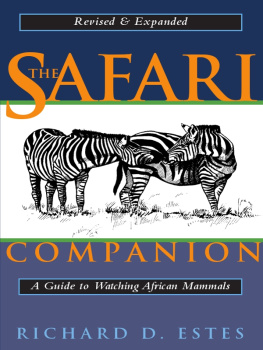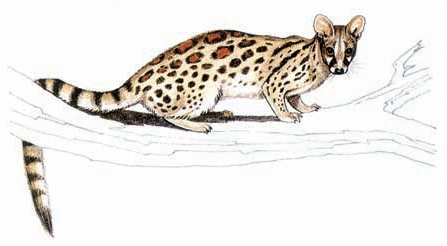SMITHERS
MAMMALS
of Southern Africa
A field guide
revised and updated by Peter Apps
Illustrations by Clare Abbott, Penny Meakin
and Noel Ashton
Spoor drawings by Hazel Smithers
Published by Struik Nature
(an imprint of Random House Struik (Pty) Ltd)
Reg. No. 1966/003153/07
Wembley Square, First Floor, Solan Street, Cape Town, 8001
PO Box 1144, Cape Town, 8000 South Africa
www.randomstruik.co.za
First published in 1986 by Southern Book Publishers (Pty) Ltd
Second edition published in 1996 by Southern Book Publishers (Pty) Ltd
Third edition published in 2000 by Struik Nature
This edition published in 2012 by Struik Nature
Copyright original text 1986: Reay H.N. Smithers
Copyright revised text 1996, 2000, 2012: Peter Apps
Copyright in illustrations 2000, 2012: Clare Abbott, Penny Meakin, Hazel Smithers,
Noel Ashton and Random House Struik (Pty) Ltd
Copyright in published edition, 2012: Random House Struik (Pty) Ltd
Publisher: Pippa Parker
Managing editor: Helen de Villiers
Editor: Julia Casciola
Design director: Janice Evans
Designer: Tessa Fortuin
Illustrators: Clare Abbott, Penny Meakin, Hazel Smithers and Noel Ashton
Proofreader: Tessa Kennedy
All rights reserved. No part of this publication may be reproduced, stored in a retrieval system, or transmitted, in any form or by any means, electronic, mechanical, photocopying, recording or otherwise, without the prior written permission of the copyright owner(s).
ISBN 978 1 77007 913 7 (Print)
ISBN 978 1 43170 152 0 (ePub)
ISBN 978 1 43170 153 7 (PDF)
Preface
The quarter of a century since publication of the first edition of Reay Smithers Land Mammals of Southern Africa A Field Guide has seen a steady expansion of knowledge about southern African mammals, and in the 12 years since its third edition there has been a radical change in our understanding of the evolutionary relationships among mammals. This fourth edition of the Small Smithers incorporates both updated information on field biology and the new names of species and higher taxa that reflect recent changes in systematics and taxonomy.
The information in the Smithers field guides has always been drawn directly from the zoological research literature and other authoritative sources, but because most of the books readers will be lay people, and a good number of them will not be native English speakers, I have avoided technical terms when there is a close enough equivalent in ordinary language. Some specialists might feel that the precision of language to which they are accustomed has been sacrificed, but specialists in any field too often forget that their technical terms are bafflingly unfamiliar to lay readers, and even to specialists in other disciplines. Readers who encounter terms that are unfamiliar, in this book or in others, can refer to the glossary on .
Clare Abbotts illustrations and Hazel Smithers spoor drawings from the first edition have proved themselves to be timeless and have been used here again, together with the colour illustrations and line drawings by Penny Meakin and Noel Ashton that first appeared in the third edition, and six new colour illustrations by Penny Meakin.
The enduring success of the Small Smithers, and especially its value to wildlife professionals, is a lasting tribute to Reay Smithers and to the researchers whose results it draws on, especially those local specialists (named on ) who contributed to the enlarged third edition.
In addition to those acknowledged in the third edition, I would like to thank Dr Hanneline Smit for providing up-to-date information and reference photographs on western, Cape and Karoo rock elephant-shrews; Dr Mac van der Merwe for photographs of Angolan free-tailed bats; Fenton Woody Cotterill for advice on bats; Hanlie Winterbach for data on lions; and the publishing team at Random House Struik, namely Pippa Parker, Helen de Villiers, Julia Casciola, Janice Evans and Tessa Fortuin.
Contributors to the 1996 third edition
The foundation for this fourth edition was laid by the contributors to the expanded third edition, and it is appropriate that they be acknowledged again.
Dr C.M. Baker: genets and mongooses.
Dr Simon Bearder: bushbabies.
Dr Gary Bronner: golden moles.
Nico Dippenaar: shrews and hedgehog.
Dr Johan T. du Toit: giraffe, kudu and impala.
Dr Neil Fairall: hyraxes.
Ken Findlay: marine mammals.
Rhidian Harrington: roan antelope.
Professor Peter Henzi: baboon, vervet monkey and samango monkey.
Dr Tim Jackson: springbok.
Professor Jenny U.M. Jarvis: mole-rats.
Dr Graham Kerley: tribe Otomyinae.
Dr M.H. Knight: black rhino, blue wildebeest, red hartebeest, gemsbok, steenbok, grey duiker, eland, Gambian giant rat.
Dr Gus Mills: lion, leopard, cheetah, wild dog and hyaenas.
Professor Mike Perrin: elephant-shrews and gerbils.
Professor Anne Rasa: suricate, banded mongoose, yellow mongoose, dwarf mongoose.
Dr P. Richardson: aardwolf.
Professor Terry Robinson: rabbits and hares.
Dave Rowe-Rowe: mustelids.
Dr A. Sliva: black-footed cat.
Peter Taylor: large-eared free-tailed bat, tribe Otomyinae, yellow mongoose.
Savvas Vrahimis: black wildebeest.
Hanlie Winterbach: African buffalo.
Introduction
A field guide has to be portable, and therefore it can provide only summaries of the available information. To make best use of limited space, the more common, accessible and better-studied species have full accounts with colour illustrations, distribution maps, spoor drawings and detailed text; species that are less likely to be encountered have brief summaries and are indicated by means of a grey bar in the margin; and some rare species are mentioned only by name. I have aimed to include as much scientifically accurate and detailed information as can be fitted into a field guide, and reliable sources of additional detailed information are given in the Further Reading list on .
Wildlife tourism in its widest sense is projected to become Africas biggest earner of foreign exchange, and while there is growing awareness of the value of the wildlife and other resources of natural areas, the challenge of reconciling immediate demands for resources with conservation on behalf of future generations has still not found an answer that satisfies the conflicting demands of Africas particular economic, social and political circumstances. Increases in human population and the demand for land continue to threaten the limited areas on which sustainable use of renewable natural resources is being practised, while political upheaval and armed conflict undermine both efforts to protect natural resources and economic development in any form.

